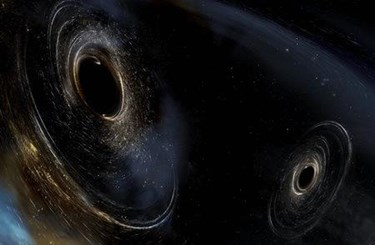LIGO Detects Gravitational Waves From Merging Black Holes For Third Time
By Jof Enriquez,
Follow me on Twitter @jofenriq

The twin advanced detectors of the Laser Interferometer Gravitational-Wave Observatory (LIGO) on Jan. 4, 2017 picked up an upward-sweeping "chirp," characteristic of gravitational waves, caused by the merger of two massive black holes some 3 billion light years away, researchers involved in the project announced recently.
The cataclysmic event of merging stellar–mass black holes – one estimated to be 31 times, the other 19 times as massive as the sun — was measured to be about twice as far away as the first black hole collision detected by LIGO on Sept. 14, 2015 (confirmed February 11, 2016). LIGO detected gravitational waves a second time on Dec. 26, 2015 (announced June 15, 2016).
"Once is chance, twice is coincidence, thrice is a pattern," wrote Michael Schirber, corresponding editor for the journal Physics, in a synopsis published with the observation of the event catalogued as GW170104, appearing June 2 in Physical Review Letters.
Interestingly, unlike the two earlier events, data during GW170104 suggest that at least one of the black holes may have had a spin that was "antialigned" with the orbital angular momentum, or the mutual direction of the two black holes as they orbited around each other before colliding. This phenomenon could explain how black hole binary systems form through more than one mechanism, contrary to what scientists theorized previously and what the two earlier signals supported.
"Here for the first time, we’re seeing antialignment is favored," said Erik Katsavounidis, senior research scientist in MIT’s Kavli Institute for Astrophysics and Space Research and a member of the LIGO team, to MIT News. "If we can detect more systems, we can nail down under what circumstances black holes formed and evolved to form binary systems that ultimately merged."
The third detection occurred during LIGO's most recent run following a period of scheduled upgrades and maintenance when scientists added components to LIGO's twin detectors in Livingston, La., and Hanford, Wash., in order to extend their range and sensitivity.
Among the advances achieved in the upgraded version called Advanced LIGO is the addition of a more stable laser which will become the basis for third generation gravitational wave detectors that will make gravitational wave detection a routine occurrence.
"We are moving in a substantial way away from novelty towards where we can seriously say we are developing black-hole astronomy," said David Shoemaker, a physicist at MIT and spokesman for the LIGO Scientific Collaboration, reported the New York Times.
A third detector in Pisa, Italy, to be operated by the Virgo Collaboration, will be online later this year, and will further enhance the quest to detect more gravitational waves, whose existence was predicted by Albert Einstein in 1916 in his general theory of relativity.
